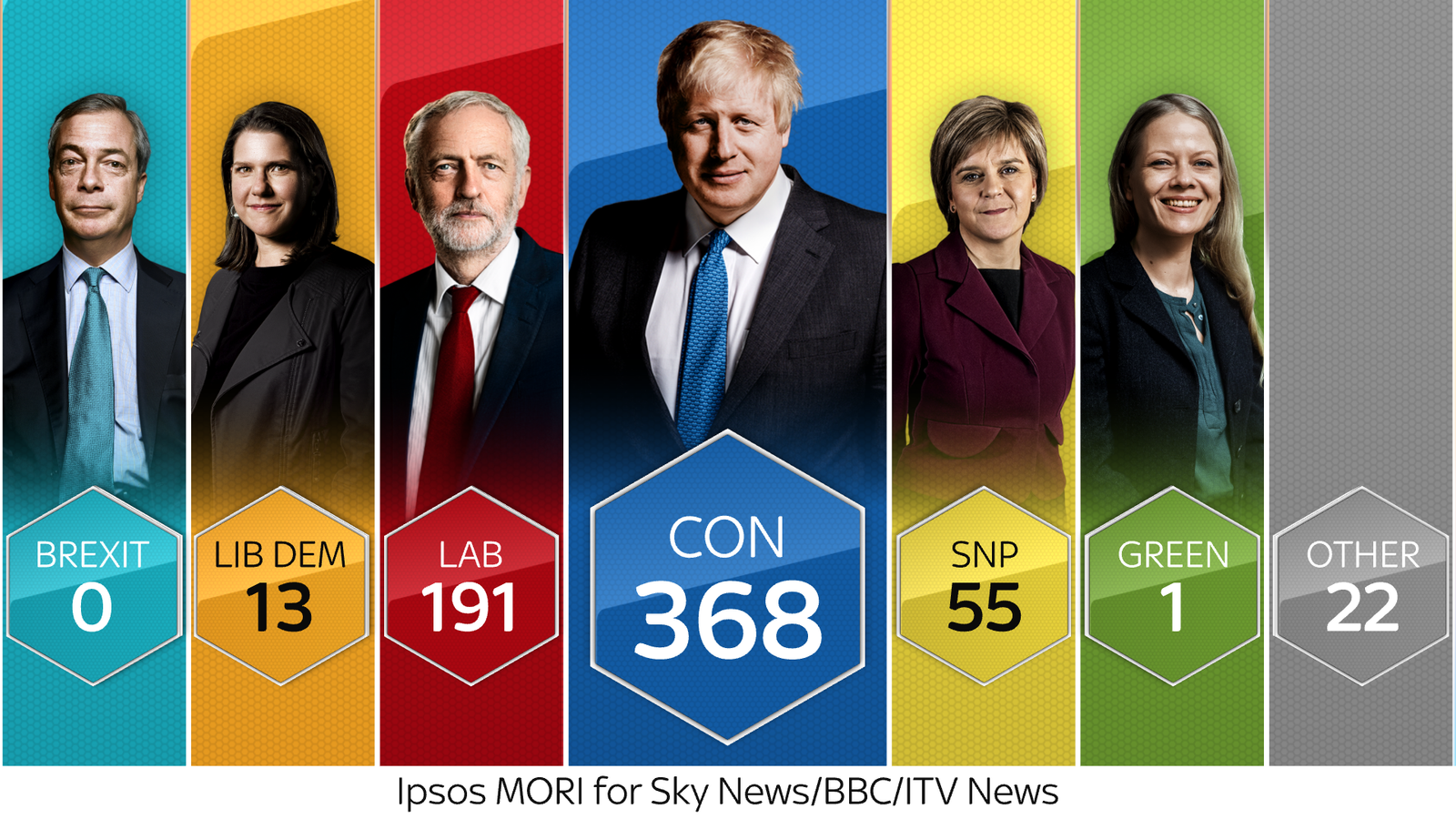I had to write something on the election for work on Friday morning. I thought it may be illuminating as (in my view) it underscores the challenges which face Labour:
1. The Exit Poll was very accurate
At 10pm the broadcasters Exit Poll was released, and Sir John Curtice's psephology with Ipsos MORI proved remarkably accurate, as this rejected pitch for a new
Avengers movie shows:
The composition of the House of Commons will be:
Conservatives - 365
Labour - 203
SNP - 48
Liberal Democrats - 11
DUP - 8
Sinn Féin - 7
Plaid Cymru - 4
SDLP - 2
Green Party - 1
Alliance - 1
This translates into a majority of 80.
The last time the Conservative Party had a majority this large was in 1987, when one Margaret Thatcher won her third straight General Election. Expect little to no opposition to the Government's legislative programme.
2. The Conservative Party are the natural party of Government
To be honest, many of us have grown up in a very misleading time.
The Labour Party were in office from 1997 to 2010, a full thirteen years. Many of us would have voted in a General Election where Labour were in power. But this length of Labour Government was an aberration.
The thirteen years of Labour rule was the longest period of non-Conservative rule in this country since
1763. The Conservatives are very much the natural party of Government.
If Boris Johnson fulfils a full five-year term (which is as close to certain as you can get), it will be
fifty years since a Labour leader other than Tony Blair won a General Election.
The Conservative Party's ruthlessness when it comes to winning elections means that it has in the past, and did yesterday, find a winning formula when many people doubted in could. In 2015, David Cameron compiled a majority out of metropolitan seats in major cities, plus the shires. Yesterday, Boris Johnson won a huge majority whilst losing London, Birmingham, Manchester, Liverpool and Newcastle, amongst others. The new Conservative Government has MPs from the shires, to be sure, but also MPs from old mining areas, towns, semi-urban areas and rural Scotland.
If the electoral maths change by the time of the 2024 General Election, do not discount the Conservative Party's ability to find a winning combination where one seemed difficult to find.
3. The Red Wall breached? More like destroyed...
What is the 'Red Wall'?
It essentially was a shorthand way of describing a swath of seats which the Labour Party held for many decades, many since before the Second World War.
The Red Wall included constituencies in the Midlands and the North which - although Labour - did vote Leave in the 2016 Referendum.
The Wall was meant to stand up to a Tory victory. It did in
1983, when Labour only won 209 seats.
Unfortunately for the Labour Party, it did not yesterday. This is, for me, the most significant part of the Election. The Conservative Party did not just win in these seats - they won convincingly. Labour will not win an election again without winning back these seats.
To illustrate, here were Labour majorities in red wall seats in 1997:
- Bolsover: 27,149 (created in 1950, never elected a Tory)
- Sedgefield: 25,143 (last elected a Tory MP in 1931, and Tony Blair's old seat)
- North West Durham: 24,754 (created in 1885, never elected a Tory)
- Leigh: 24,496 (created in 1885, never elected a Tory)
- Bishop Auckland: 21,064 (created in 1885, never elected a Tory)
- Redcar: 21,664 (last elected a Tory MP in 1959)
- Stoke on Trent Central: 19,924 (created in 1950, never elected a Tory)
- Workington: 19,656 (created in 1918, never elected a Tory at a General Election)
- Blyth Valley: 17,736 (last elected a Tory MP in 1931)
- Bassetlaw: 17,460 (last elected a Tory MP in 1910)
- Stoke on Trent North: 17,392 (created in 1950, never elected a Tory)
- Great Grimsby: 16,244 (last elected a Tory MP in 1924)
- Darlington: 16,025 (last elected a Tory MP in 1983)
- Wakefield: 14,604 (last elected a Tory MP in 1931)
- West Bromwich West: 13,584 (last elected a Tory MP in 1931)
- West Bromwich East: 11,355 (from 2001, was the Speaker's seat in 1997 - last elected a Tory MP in 1931)
All listed have gone blue (and I have missed a number out too for the sake of brevity).
Will this new constituency representation change the nature of the Conservative Party? Previously they haven't had to think about these communities - now they represent them.
4. 2019 is worse for Labour than 1997 was for the Conservative Party
In
1997, the Conservative Party received its worst election result since 1832.
They ended up with 9.6m votes, 30.7% of the vote, and only 165 seats. In the 2019 Election, Labour's figures were better on all counts. However, I think that this result is much worse for Labour.
Here is the electoral map from 1997:
Importantly for the Conservative Party, the seats it hanged on to were generally very safe, and provided a base for the long rebuilding in the elections to follow. Likewise, their voting base in 1997 was stable and could be relied upon for future votes.
Now, here is 2019:
Unlike 1997, Labour does not have the same solid base as the Conservative Party did. In addition, many of the seats it did hang on to (for example, Dagenham and Rainham), were secured with razor thin majorities and would be vulnerable to minor swings
at a constituency level. This means that if the Labour Party could be vulnerable to losses both if they decide to remain as left-wing as they are now, and if they choose a centrist path.
The electoral map has been redrawn, perhaps permanently. This image from
The Times illustrates the swings both toward Labour in 2017, and the simply massive swing away from Labour yesterday:
These swings have meant that the Conservative Party now either holds traditional Labour seats, or is running them very close in their heartlands. In short, the Conservative Party in 1997 could effectively follow the old rules and approaches to politics in rebuilding. The Labour Party does not have this luxury, even if the Conservative vote fell in Remain areas.
5. Oh... Jeremy Corbyn....
In terms of seats, this is Labour's worst electoral performance since the
1935 General Election. There, led by one Clement Attlee, Labour won just 145 seats.
However, in 1931 Labour won just 52 seats (in part due to that pesky Zinoviev letter), and Attlee was only appointed a month before the Election to replace one
George Lansbury, a white haired bearded pacifist who opposed rearmament in the face of German fascism. After making a speech at Labour Conference extolling the virtues of pacifism and opposing sanctions against aggressive countries, Ernest Bevin (the future Home Secretary), accused Lansbury of putting his private beliefs ahead of a policy agreed by the Party, and accused him of "hawking [his] conscience round from body to body asking to be told what to do with it".
Already the recriminations have started. Ian Lavery (if he offers to sort out a pension for you,
read this first) felt that Labour's defeat was solely to do with the Party not supporting Leave. Momentum and other supporters of the Labour leader have framed the election as completely dominated by Brexit, and Laura Parker of Momentum stated that:
Yet it was indisputable that Corbyn himself was an issue on the doorstep - see
here and
here.
He declared at his count he would not lead Labour into another election, but has not as of yet resigned.
If he does, the next Leader would in all likelihood be from the left of the Party, given the fact that the Labour membership has become more and more left-wing since Corbyn's election in 2015.
Potential names for a successor include Sir Keir Starmer, Jess Phillips, Rebecca Long-Bailey, and Emily Thornberry. At her count, Thornberry proclaimed:
Good to know she winged it during the Election....
6. The Portillo Moment?
Several contenders here.
First up has to be
Jo Swinson, who lost her seat of East Dunbartonshire, and the Leadership of the Liberal Democrats.
Dennis Skinner lost his seat after 49 years, meaning Sir Peter Bottomley is the new
Father of the House.
Zac Goldsmith lost in Richmond Park, Nigel Dodds (leader of the DUP at Westminster) lost his Belfast seat, and Laura Pidcock (who was massively unpopular in her constituency) managed to lose North West Durham to the Conservatives for the first time ever.
Any other nominations?
7. Northern Ireland
For the first time
ever, Northern Ireland will return more Nationalist MPs than Unionist MPs.
The SDLP won Foyle from Sinn Féin, and Belfast South from the DUP. In addition, the Alliance Party won Down North. This means that (unlike the last Parliament), there will be a Remain voice from Northern Ireland (as Sinn Féin do not take their seats).
The longer-term implications of the Prime Minister's Brexit deal, and the potential customs checks between Great Britain and Northern Ireland, are yet to be seen. The Speaker will call the Alliance and SDLP MPs in all Brexit debates so their voice will be heard. However, if Nationalist MPs retain this majority of Westminster seats, and translate that into a majority at Stormont, will the prospect of a united Ireland become closer to realisation?
8. Should I stay or should I go?
The SNP's rediscovered dominance north of the border brings the prospect of a second Scottish Independence Referendum into view. It is likely that Nicola Sturgeon will make a formal request for a referendum this month. It is equally likely that the Prime Minister will refuse this.
How will Remain voting Scotland react to the fact that the UK is now on course to leave the EU in 2020?
This debate will likely be played out via the media, and via the elections for the Scottish Parliament in 2021.
Will Scotland vote for independence if that means both leaving the UK
and remaining outside of the EU, with potential accession talks to traverse?
9. Will we ever see a Labour Government again?
A serious question.
Labour have always depended on winning seats in the North-East, North-West, West Midlands, Wales and Scotland to win a majority.
Now they are fourth in Scotland, having been first there until 2015.
The Conservatives have eaten into their traditional base in England and Wales, with many seats which had never returned a Conservative MP until recently now having impregnable Tory majorities. A classic example is Mansfield. Having never returned a Tory MP until 2017, Ben Bradley now has a majority of over 16,000.
When Labour held 209 seats in 1983, it took three General Elections and fourteen years for them to return to power, and as pointed out above history may not repeat itself.
No party has ever come back from Labour's position to win a majority in the next election. This means that - in practical terms - there will likely be two full terms of Conservative majority Government. This would mean that the Conservatives would be in Government for twenty years.
In my view, this is too optimistic for Labour, given the structural difficulties they face electorally. If they do well, pick the right leader and policies, three electoral cycles could return a Labour majority. So set a date in your diaries for 2034 and see how accurate I am....






